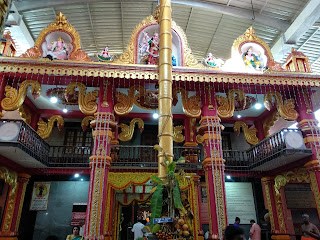 |
| Beauty of Temple chariot (Ratha or Teru), Mundkuru. |
Ooru (or Ūru) is a common Dravidian word for village or habitation and
it occurs as a suffix in many South Indian place names as a suffix (or last
part of the word).
Comparatively, there are also several ancient village names in coastal
Tulunadu that end with a suffix of –kūru.
For example: Nandikūru, Mundkūru, Balkuru,
Barkuru, Saukūru.. etc. Similar –kūru ending place names are common place
in the eastern parts of peninsular Andhra Pradesh/Telangana region.
Now, what was the difference between Ūru
and Kūru? Or why some village-names
were chosen and named with the suffix of –kūru,
while simple suffix of Ūru
would have been suffice?
Some readers may confuse the suffix: kūru
with kuru. The ‘kuru’ (as in Kurukshetra), means a hilly region, whereas kūru (ku+ūru) is an alternate compound form of the
common Dravidian word ūr (or oor ). The kuru (and its alternate form, kor)
is a part of tribal group names such as Kor,
Korava, Koraga etc.
Kūru
villages
Village names such as Athikur,
Bailkur, Balkur, Barkur, Betkur, Bhankur, Chowkur, Halkur, Huskur, Kandakur,
Karekura, Tumkur, Nandikūru,
Mundkūru, Balkuru, Barkuru, Saukūru.. in Karnataka and Agomothkur,
Andukuru, Anukuru, Atmakuru, Bhuthkur, Chillakur, Ikhuru, Kondikur, Modukuru,
Nadakuru, Birkoor etc in Andhra Pradesh serve as some of the examples for
villages ending with -kūru suffix.
Kūru: an analysis
Thus, the suffix word/component kūru
can be analysed as: ku+ūru. Regarding
the meaning of the component ku here,
there can be two possible answers:
1. The suffix tag of -ka (or -ku or -ki ) was one of
the oldest decipherable habitation indicator tag, which was used in those days
of early civilization, to refer to a small human colony or habitation of say
less than about 100 people. Village names like: Baraka, Bekha, Booka, Dabka, Gokak, Hebbaka, Kabaka, Moka etc in different
parts of Karnataka can be offered as examples for ancient village names ending
with -ka . Here the suffix –ka or -kha
represents a habitation or a tiny ancient village.
2. In some of the ancient Indian languages, a prefix tag of “ku” served to mean good, beautiful,
auspicious etc. For example: the ancient word “kumāra” was formed by joining,
ku and māra.
Of the two options discussed
above, the first one appears realistic as there are many ancient habitation
names ending with -ka, -kh, -ke, -ki or -ku. ( For example: Kabaka, Moka, Gokak, Alike,Belke,Barke, Kukke,Jowku etc).
Small ancient habitations
Human evolution grew in the form of small habitations and these colonies
were designated with simple suffix tags that ended with ka (or its phonetic variants) or with similarly simpler consonants
such as: ta, pa sa, ya ..etc. We shall cover more these aspects in some of
our forthcoming posts. Primitive words were simpler consonants which evolved
with time to form more complex words.
Antiquity of word Ūr ( Oor)
The word Ūr ( or Oor) has widely accepted as a common
word for village in Dravidian languages including Tulu. However, the word does
not appear to be the exclusive property of Dravidian languages of India.
Sumerian civilization, that flourished some 6000 years ago in Mediterranean
region had a town known as Ur!. This
confirms that about 6000 years before present the word Ur existed in Mediterranean region also! Whether the ancient
Dravidians borrowed the word Ur from
the ancient Sumerians or vice versa can only be finalized after intensive
research into the available historical data. But the fact remains that Uru was a global word that existed at
least since 6000 years.
Evolution of -kuru
suffix
The discussion above leads us to conclude that the spatial suffixes like
-kuru grew as the human settlements grew in population and
size. Words like Uru represented evolved villages that possibly contained hundreds
of people. As the size and strength of
the human colonies increased new words like –uru
(= village) were added to the old habitation names that previously ended
with a simple suffix such as -ka.
In other words the original or older village names were Mundaka, Nandika, Baraka etc which later
with addition of –uru suffix, became
Mundkūru, Nandikūru, Barkūru .. etc.
Mundaka+ūru=
Mundakūru
Nandika+ūru=Nandikūru
Baraka+ūru=Barakūru
etc..
(Notes: Munda refers to the
name of an ancient tribe; Nandi= a
bull ; or Nanda = a tribe; Bāra= an estuary; river mouth at sea beach)
Antiquity of spatial suffix -ka
Our proposed model of evolution
of habitation/village names based on the sequence of affixation of spatial tags
of -uru over –ka, suggests that the suffix -ka
might be much more older than -uru ,
may be about 10,000 years old . Similar to the word Ur, the suffix ka is not
only ancient but also global in extent as you can find similar suffix tags in
African/Mediterranean ancient country names such as : Iraq , Morocco, etc.
R
 |
| The josh of temple festivities, Mundkuru, Udupi district, Karnataka. |



No comments:
Post a Comment